Getting Started Showing Poultry
By Tim Daniels
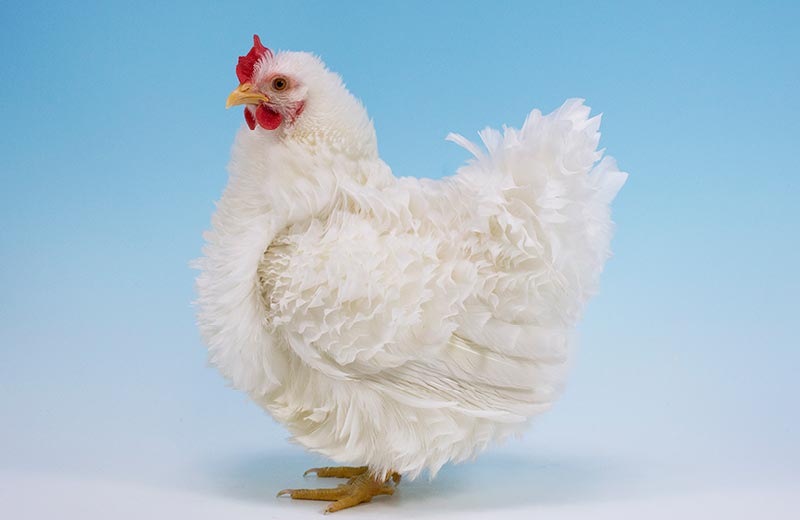
Breeding and showing your poultry can be extremely rewarding, and there are many fanciers entering poultry shows across the UK. One of the most significant one-day events is the High Peak Poultry Club Championship Poultry and Egg Show, held in Derbyshire. This show attracts entries from as far afield as Scotland, Wales, and England’s far corners. Newcomers are welcome, but how do you get started showing your birds?
Over the last decade, chicken keeping has grown in popularity. It’s certainly an addictive hobby. Many people initially motivated by having home-produced eggs have been “bitten by the bug” and moved on to incubate and hatch some pure breeds at home.
Once you have learned the basics about breeding chickens, you will soon find hatch rates improving and will start to have more birds available for the following year’s breeding pen.
There is a breed standard to follow, and many breeds have a club that may provide additional guidance. However may find yourself questioning your interpretation of the standard; or may have just hatched a few stunning birds you would like to show off, so where better to take these birds than to a show!
Entering your birds into a show allows you to compare with others in the same class. In addition, you often get an opportunity to talk to other breeders and judges. If you happen to get lucky, you may even end up talking to fanciers with many decades of experience who will often be happy to look over your birds and give you some pointers. Who knows, you may even come back with a card or even a trophy if you do well!
The High Peak Poultry Club (HPPC) motto is “The friendly club”, and many enthusiastic members are willing to help the newcomer with interest in The Fancy, so if you haven’t entered a show before, it’s a great place to start.
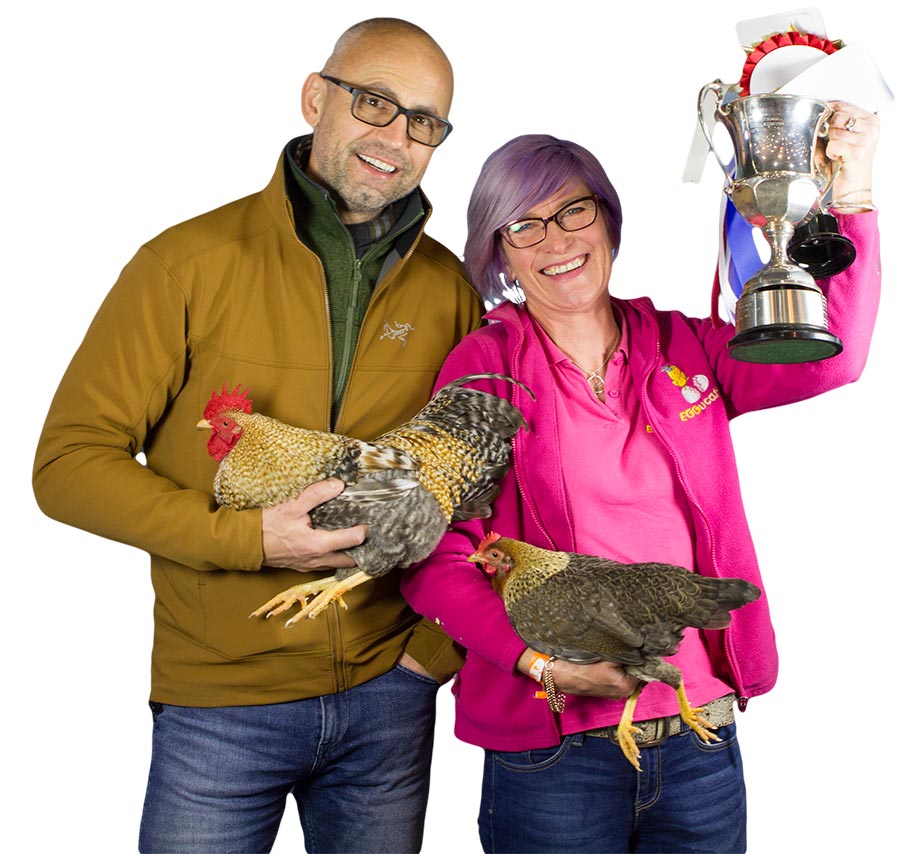
Poultry Classes
The first step to entering a show is to decide on the ‘Class’ you will enter. There are many different pure breeds you can enter into a show, so make sure you select the correct one. Most show secretaries make the schedule and entry form available online, but many will still post them for a small fee to cover postage and printing. The HPPC website has a show news page where you can find details of the next show and download a schedule.
If you browse through the schedule, you will see bantams and large fowl classes, so make sure you enter the right one.
If you find your breed doesn’t have a class, you should enter it into “Any Other Variety (AOV)”, but keep in mind rare breeds do not have a breed club, so come under the care of the Rare Poultry Society. The Asian Hard Feather breeds also have a separate class. If you are in any doubt, speak to the show secretary for some advice.
Utility breeds (those selected primarily for good egg production or table qualities) such as the Marans, Light Sussex or Leghorn also have a class, so you may have to decide between the utility or breed class.
You can also enter eggs into classes, so if you’re taking birds to a show, why not enter some eggs as well? Remember, they may be broken open and the contents judged, so be sure to take fresh eggs.
Junior exhibitors are well catered for, with most shows having separate classes for them. It’s always great to see so many younger fanciers coming to these shows.
Once you have decided on which classes you will enter, an entry form should be completed and returned to the show secretary, together with the correct entrance fees for each bird you enter. Be sure to note the deadline, which is always some weeks before the show to allow organisers to book the required number of pens.
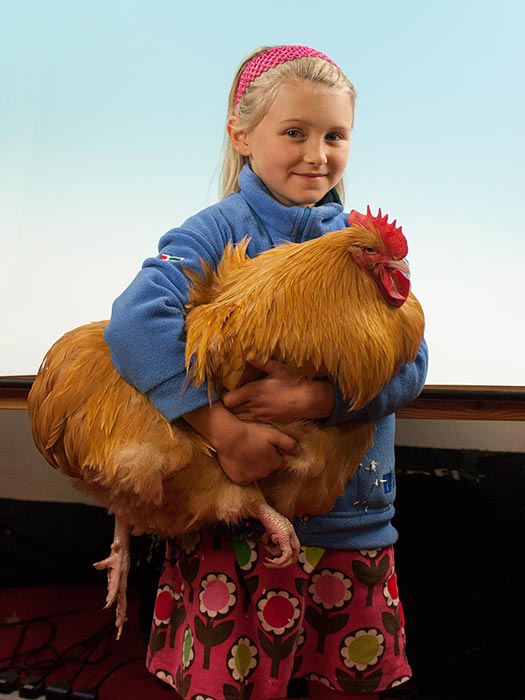
Show preparation
In the run-up to the show, it is vital to keep your birds as clean as possible and provide them with the best diet for them to look good on the day. Above everything else, you must enter fit and healthy birds.
Serious fanciers keep their birds indoors in ‘penning sheds’ during the final month or two before the show. It avoids the obvious mud from spoiling their plumage, but sunlight and grass can also cause feathers to discolour. A couple of feathers pecked out in the wrong place can ruin your best bird, so separate male and female birds and keep an eye out for bullying.
The judge will take your bird out of the cage to examine it closely, so it is helpful if your bird is relaxed and can be easily handled.
Cage training and handling at home before the show acclimatises your birds. I started by using a large puppy crate to train my birds (some people use a rabbit hutch). Place birds in their cages every day for a couple of weeks before the show and give them some treats. They will soon realise that a hand coming into the cage means something pleasant is coming, and in turn, it will help them relax before being picked up.
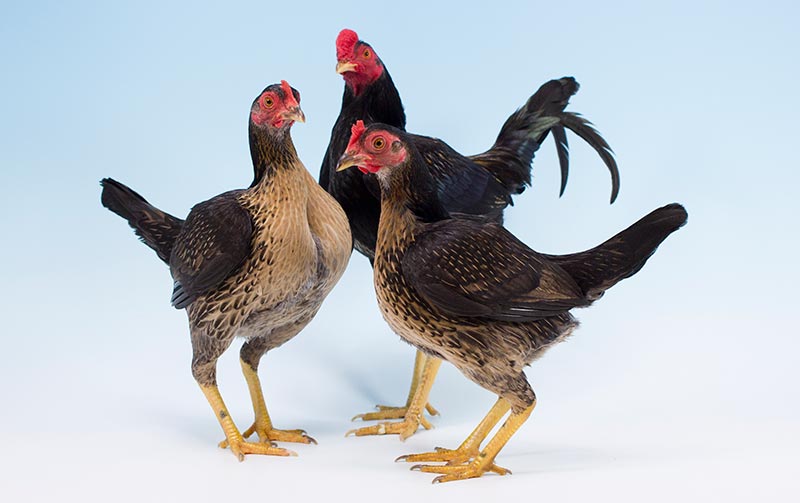
The day before the show
Before the show, you will need to wash your bird using warm water and baby shampoo. Strangely, most birds will settle and don’t mind this, providing the water is warm and not too deep. A small nailbrush helps get their feet and legs clean. A jug can be helpful to pour water gently over the bird but do avoid the head. When you have finished, wrap them in a towel before blow-drying their feathers gently with a gentle heat setting.
Ducks and Geese should not be washed with shampoo. Washing will remove the oils that waterproof their feathers, so after the show, you’ll have birds that will get soaked through and become very cold during the wet winter months. Waterfowl do a fine job of washing themselves- put them into a clean area such as a shed and provide them with clean water in a tub to bathe in every day in the run-up to a show.
The day of the show
The Poultry Club of Great Britain provides the guidelines for poultry shows. Judges have been qualified to Poultry Club standards or are experts in the breed. They will be working hard in the morning because they often have 100 or more birds to judge, so it is essential to ensure your birds are caged and settled when judging starts. Generally, it would be best to give your birds at least 30 minutes to relax before judging.
The judging system in the UK is a comparison system, where a judge places birds in 1st to 3rd, sometimes 4th position. A prize card is awarded, and from the winners, birds can win higher awards such as the coveted ‘Best in Show’. For these awards, there can be shields and trophies.
Judges often take a steward to take notes for them. These serve as a reminder of their findings as they work through their allotted classes.
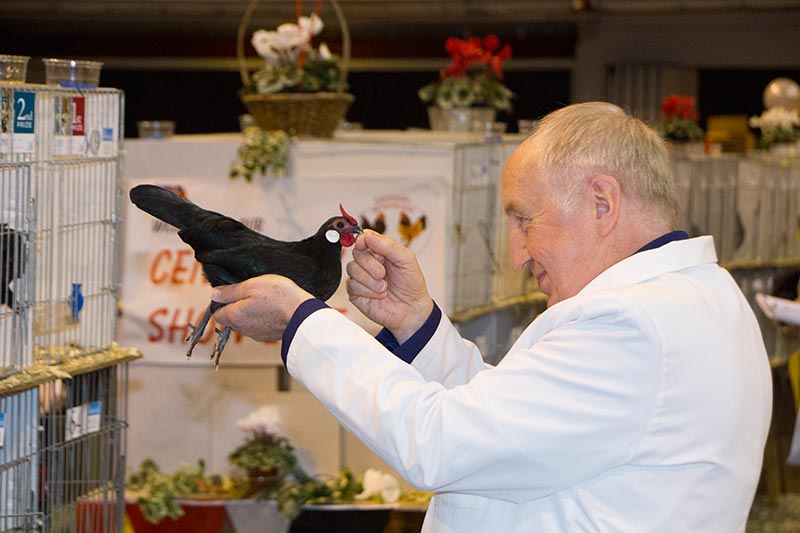
Whilst judges are working; please do not interrupt them.
You are responsible for feeding and watering your birds, so as soon as possible, after judging has been completed, you will need to place a clip-on feeder and drinker into the cage.
The judge or steward will place prize cards onto the cages; if you receive one, it is courteous to leave it in place until the show’s end to allow others to see which birds got placed.
Even with some of the best birds, it’s hard to know how well you’ll do at a show, but even if you only gain some experience and have some good banter on the day, it’s a fun day out. Whatever happens, you will undoubtedly make some new friends along the way.
Text and photos are copyright of the author.
Breeding Chickens article: https://poultrykeeper.com/poultry-breeding/breeding-chickens/